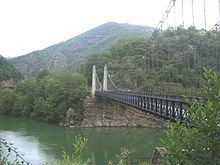Population (2010) 214 Area 23.14 km² | Region Occitanie Time zone CET (UTC+1) Local time Saturday 7:04 AM | |
 | ||
Weather 4°C, Wind SW at 27 km/h, 94% Humidity | ||
Cloches de vabrette cne d ayss nes 12
Ayssènes is a French commune in the Aveyron department in the Occitanie region of southern France.
Contents
- Cloches de vabrette cne d ayss nes 12
- Map of 12430 AyssC3A8nes France
- P na los fest jaires f te des la fraise ayss nes dans l aveyron 2012
- Geography
- Middle Ages
- Modern Era
- Contemporary era
- Administration
- Demography
- Sites and monuments
- Notable people linked to the commune
- References
Map of 12430 Ayss%C3%A8nes, France
The inhabitants of the commune are known as Ayssenols or Ayssenoles.
P na los fest jaires f te des la fraise ayss nes dans l aveyron 2012
Geography
Ayssènes is located some 25 km west of Millau and 7 km south-east of Alrance. Access to the commune is by the D510 road from Villefranche-de-Panat in the west which passes through the commune by a circuitous route to the village then continues south across the river to join the D200 on the opposite bank. Apart from the village there are the hamlets of:
The commune is mainly forest with large areas of farmland.
The southern border of the commune is formed by the Tarn river which is dammed just south-west of the commune to form a long lake along the southern border. From the dam the Tarn continues south-west to eventually join the Garonne just west of Moissac. The Ruisseau de Vernobre rises in the north of the commune and flows south, gathering many tributaries, to join the Tarn. The Ruisseau de Coudols flows from the north-east, gathering some tributaries in the commune, and joins the Tarn at the same point as the Ruisseau de Vernobre.
Middle Ages
The village was built on a ridge overlooking the Tarn and was a direct link between the Lévézou Plateau and Raspes du Tarn. There was once a fortress on the peak of Roc Saint-Jean. It belonged to the Count of Rodez who maintained a garrison in order to maintain his influence over the southern Rouergue. Prestigious guests stayed at this location including the King of France, Charles VII, on 13 May 1437 while returning from Languedoc where he had been to restore order.
Modern Era
The castle was the subject of much covetousness during the wars of religion. In October 1586 the army of the Duke of Joyeuse, Anne de Joyeuse - brother of King Henry III, tried to besiege it. The Captain of the garrison made a ploy and the duke's army retreated towards the plateau of Saint-Victor which was where the garrison captain attacked the camp at night - taking fifty horses and capturing several soldiers. The fortress became dangerous for the kingdom and was destroyed in 1629 by order of Cardinal Richelieu. Today nothing remains but the location has one of the most beautiful views in the region.
Contemporary era
The commune consisted of four parishes in the second half of the 19th century with a population of around 1500. Today there are no more than 213 year-round residents.
Administration
List of Successive Mayors
(Not all data is known)
Demography
In 2010 the commune had 214 inhabitants. The evolution of the number of inhabitants is known from the population censuses conducted in the commune since 1793. From the 21st century, a census of communes with fewer than 10,000 inhabitants is held every five years, unlike larger communes that have a sample survey every year.
Sources : Ldh/EHESS/Cassini until 1962, INSEE database from 1968 (population without double counting and municipal population from 2006)
